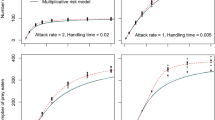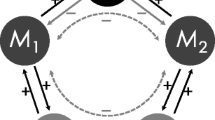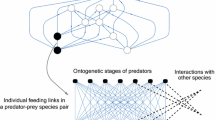Abstract
Suppression of a target prey by a predator can depend on its surrounding community, including the presence of nontarget, alternative prey. Basic theoretical models of two prey species that interact only via a shared predator predict that adding an alternative prey should increase predator numbers and ultimately lower target pest densities as compared to when the target pest is the only prey. While this is an alluring prediction, it does not explain the numerous responses empirically observed. To better understand and predict the indirect interactions produced by shared predation, we explore how additional prey species affect three broad ecological mechanisms, the predator's reproductive, movement, and functional responses. Specifically, we review current theoretical models of shared predation by focusing on these mechanisms, and make testable predictions about the effects of shared predation. We find that target predation is likely to be higher in the two prey system because of predator reproduction, especially when: predators are prey limited, alternative or total prey density is high, or alternative prey are available over time. Target predation may also be greater because of predator movement, but only under certain movement rules and spatial distributions. Predator foraging behavior is most likely to cause lower target predation in the two-prey system, when per capita predation is limited by something other than prey availability. It is clear from this review that no single theoretical generalization will accurately predict community-level effects for every system. However, we can provide testable hypotheses for future empirical and theoretical investigations of indirect interactions and help enhance their potential use in biological control.
Similar content being viewed by others
References
Abrams, P. A.,1987.Indirect interactions between species that share a predator:varieties of indirect effects. In:W. C. Kerfoot and A. Sih (eds),Predation:Direct and Indirect Impacts on Aquatic Communities.University Press of New England, Hanover, NH. pp.38–54.
Abrams, P. A.,1999.Is predator-mediated coexistence possible in unstable systems?Ecology80:608–621.
Abrams, P. A.,R. D. Holt and J. D. Roth,1998.Apparent competition or apparent mutualism?Shared predation when populations cycle. Ecology79:201–212.
Abrams, P. A. andH. Matsuda,1996.Positive indirect effects between prey species that share predators.Ecology77:610–616.
Allee, W. C.,1931.Animal Aggregations.A Study in General Sociology.University of Chicago Press, Chicago, IL.
Andow, D. A.,1991.Vegetational diversity and arthropod population response.Annu. Rev. Entomol.36:561–586.
Billick, I. andT. J. Case,1994.Higher order interactions in ecological communities: what are they and how can they be detected?Ecology75:1529–1543.
Bonsall, M. B. andM. P. Hassell,1999.Parasitoid-mediated effects:apparent competi tion and the persistence of host-parasitoid assemblages.Res. Popul. Ecol.41:59–68.
Chaneton, E. J. andM. B. Bonsall,2000.Enemy-mediated apparent competition: empirical patterns and the evidence.Oikos88:380–394.
Charnov, E. L.,1976.Optimal foraging, the marginal value theorem.Theor. Popul. Biol. 9:129–136.
Coll, M. andM. Guershon,2002.Omnivory in terrestrial arthropods:mixing plant and prey diets.Annu. Rev. Entomol.47:267–297.
Collier, T. R.,W. W. Murdoch and R. M. Nisbet,1994.Egg load and the decision to host-feed in the parasitoid. Aphytis melinus.J. Anim. Ecol.63:299–306.
Comins, H. N. andM. P. Hassell,1976.Predation in multi-prey communities.J. Theor. Biol.62:93–114.
Comins, H. N. andM. P. Hassell,1996.Persistence of multispecies host-parasitoid interactions in spatially distributed models with local dispersal.J. Theor. Biol.183:19–28.
Courchamp, F.,M. Langlais and G. Sugihara,2000.Rabbits killing birds:modelling the hyperpredation process.J. Anim. Ecol.69:154–164.
Fox, L. R. andP. A. Morrow,1981.Specialization:species property or local phenomenon?Science211:887–893.
Hamba ¨ck, P. A.,1998.Seasonality, optimal foraging, and prey coexistence.Am. Nat. 152:881–895.
Hamba ¨ck, P. A. andC. Bjo ¨rkman,2002.Estimating the consequences of apparent competition:a method for host-parasitoid interactions.Ecology83:1591–1596.
Harmon, J. P.,2003.Indirect interactions among a generalist predator and its multiple foods. Ph. D. Thesis, Department of Entomology, University of Minnesota. 184 pp.
Hassell, M. P.,2000.The Spatial and Temporal Dynamics of Host-Parasitoid Interactions.Oxford University Press, Oxford.
Heimpel, G. E.,C. Neuhauser and M. Hoogendoorn,2003.Effects of parasitoid fecundity and host resistance on indirect interactions among hosts sharing a parasitoid.Ecology Letters6:556–566.
Hodek, I. andA. Honek,1996.Ecology of Coccinellidae.Kluwer Academic Publishers, Dordrecht, The Netherlands.
Holling, C. S.,1959a.The components of predation as revealed by a study of small-mammal predation of the European pine saw. y.Can. Entomol.91:293–320.
Holling, C. S.,1959b.Some characteristics of simple types of predation and parasitism. Can. Entomol.91:385–398.
Holt, R. D.,1977.Predation, apparent competition, and the structure of prey communities.Theor. Popul. Biol.12:197–229.
Holt, R. D.,1983.Optimal foraging and the form of the predator isocline.Am. Nat.122:521–541.
Holt, R. D.,1984.Spatial heterogeneity, indirect interactions, and the coexistence of prey species.Am. Nat.124:377–406.
Holt, R. D.,1987.Prey communities in patchy environments.Oikos.50:276–290. 4Holt, R. D., 1997a. Community modules. In:A. Gange and V. Brown (eds), Multitrophic Interactions in Terrestrial Systems, 36th Symposium of the British Ecological Society. Blackwell Science, Oxford. pp.333-350.
Holt R. D.,1997b.From metapopulation dynamics to community structure:some consequences of spatial heterogeneity. In:I. A. Hanski and M. E. Gilpin (eds), Metapopulation Biology.Academic Press, New York, NY. pp.149–165.
Holt, R. D. andM. Barfeld,2003.Impacts of temporal variation on apparent competition and coexistence in open ecosystems.Oikos101:49–58.
Holt, R. D.,J. Grover and D. Tilman,1994.Simple rules for interspecific dominance in systems with exploitative and apparent competition.Am. Nat.144:741–771.
Holt, R. D. andM. E. Hochberg,2001.Indirect interactions, community modules and biological control:a theoretical perspective. In:E. Wajnberg, J. K. Scott and P. C. Quimby (eds),Evaluating Indirect Ecological Effects of Biological Control.CABI Publishing, Wallinkford, Oxon, UK. pp.13–38.
Holt, R. D. andB. P. Kotler,1987.Short-term apparent competition.Am. Nat.130:412–430.
Holt, R. D. andJ. H. Lawton,1993.Apparent competition and enemy-free space in insect host-parasitoid communities.Am. Nat.142:623–645.
Holt, R. D. andJ. H. Lawton,1994.The ecological consequences of shared natural enemies.Annu. Rev. Ecol. Syst.25:495–520.
Jacob, H. S. andE. W. Evans,2000.Influence of carbohydrate foods and mating on longevity of the parasitoid Bathyplectes curculionis (Hymenoptera:Ichneumonidae). Environ. Entomol.29:1088–1095.
Jervis, M.,1998.Functional and evolutionary aspects of mouthpart structure in parasitoid wasps.Biol. J. Linn. Soc.63:461–493.
Jervis, M. A.,N. A. C. Kidd, M. G. Fitton, T. Huddleston and H. A. Dawah,1993. Flower-visiting by hymenopteran parasitoids.J. Nat. Hist.27:67–105.
Jeschke, J. M.,M. Kopp and R. Tollrian,2002.Predator functional responses:discriminating between handling and digesting prey.Ecol. Monogr.72:95–112.
Kondoh, M.,2003.High reproductive rates result in high predation risks:a mechanism promoting the coexistence of competing prey in spatially structured populations. Am. Nat.161:299–309.
Krivan, V.,1996.Optimal foraging and predator-prey dynamics.Theor. Popul. Biol.49:265–290.
Leibold, M. A.,1996.A graphical model of keystone predators in food webs:trophic regulation of abundance, incidence, and diversity patterns in communities.Am. Nat. 147:784–812.
Levins, R. andR. Lewontin,1985.The Dialectical Biologist.Harvard University Press, Cambridge, MA.
McGregor, R.,1997.Host-feeding and oviposition by parasitoids on hosts of different tness value:influences of egg load and encounter rate.J. Insect Behav.10:451–462.
Muller, C. B. andH. C. J. Godfray,1997.Apparent competition between two aphid species.J. Anim. Ecol.66:57–64.
Murdoch, W. W.,1973.The functional response of predators.J. Appl. Ecol.10:335–342.
Namba, T.,A. Umemoto and E. Minami,1999.The effects of habitat fragmentation on persistence of source-sink metapopulations in systems with predators and prey or apparent competitors.Theor. Popul. Biol.56:123–137.
Noy-Meir, I.,1981.Theoretical dynamics of competitors under predation.Oecologia50:277–284.
Polis, G. A.,C. A. Myers and R. D. Holt,1989.The ecology and evolution of intraguild predation:potential competitors that eat each other.Annu. Rev. Ecol. Syst.20:297–330.
Rosenheim, J. A.,1998.Higher-order predators and the regulation of insect herbivore populations.Annu. Rev. Entomol.43:421–447.
Rosenheim, J. A.,H. K. Kaya, L. E. Ehler, J. J. Marois and B. A. Jaffee,1995.Intraguild predation among biological-control agents:theory and evidence.Biol. Control5:303–335.
Solomon, M. E.,1949.The natural control of animal populations.J. Anim. Ecol.18:1–35.
Symondson, W. O. C.,K. D. Sunderland and M. H. Greenstone,2002.Can generalist predators be effective biocontrol agents.Annu. Rev. Entomol.47:561–594.
Ueno, T.,1999.Host-feeding and acceptance by a parasitic wasp (Hymenoptera:Ichneumonidae)as influenced by egg load and experience in a patch.Evol. Ecol.13:33–44.
van Baalen, M.,V. Krivan, P. C. J. van Rijn and M. W. Sabelis,2001.Alternative food, switching predators, and the persistence of predator-prey systems.Am. Nat.157:512–524.
Whelan, C. J.,J. S. Brown and G. Maina,2003.Search biases, frequency-dependent predation and species co-existence.Evol. Ecol. Res.5:329–343.
Wootton, J. T.,1994.The nature and consequences of indirect effects in ecological communities.Annu. Rev. Ecol. Syst.25:443–466.
Wootton, J. T.,2002.Indirect effects in complex ecosystems:recent progress and future challenges.J. Sea Res.48:157–172.
Author information
Authors and Affiliations
Rights and permissions
About this article
Cite this article
Harmon, J., Andow, D. Indirect effects between shared prey: Predictions for. BioControl 49, 605–626 (2004). https://doi.org/10.1007/s10526-004-0420-5
Issue Date:
DOI: https://doi.org/10.1007/s10526-004-0420-5




